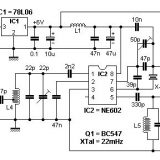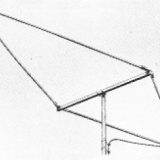Calculations and Simulations with Pads and Feedback Amplifiers
One of my favorite circuits uses a bipolar transistor with two forms of negative feedback. One is parallel feedback in the form of a resistance from the output collector back to the input base. The other feedback is emitter degeneration. We devoted an entire section (2.7) to this circuit in the discussion of amplifiers in Chapter 2 of Experimental Methods in RF Design.
We often follow these circuits with an attenuator or pad. Although this topology is one that has been around for a long time, the role of the pad is not universally understood. We thought it would be useful to examine the circuit with some readily available software tools. We will begin with a look at a pad and what it does to improve termination impedance. Then we investigate a feedback amplifier. The first amplifier will have a pure resistive termination, but this is soon replaced with a narrow bandwidth load. We then make things even worse with a terminated bandpass filter as a load. Finally, we insert a pad at the amplifier output and examine the results.
The software we use is all available at no cost on the internet. One of the programs is SPICE while the other is a Smith Chart program. If you are one of the many radio amateurs (or for that matter, engineers) who do not “embrace” the Smith Chart, just read past those sections.
An editorial aside: I am generally not one to advocate excess use of circuit simulators. All too often such programs generate an attitude that “you don’t have to build it if you can simulate it.” This is just not true. It has always been my experience that a circuit that has been simulated to death, often for weeks on end, is always much better understood after that same circuit is exercised for just an afternoon on the bench.
There is just nothing like experiments with measurements. On the other hand, simulators can be used to investigate circuits, refine component values, and actually expand our intuition about those circuits. But this happens best when great care is used in the simulation, sometimes including refinements such as parasitic reactances. I think that the best thing to recommend for the student or the radio amateur experimenter is to integrate his or her simulations with a liberal dose of experiments. These experiments should include, in the case at hand here, measurement of input return loss to amplifiers.
Pads
The pad, or resistive attenuator is a usually symmetrical circuit designed around a characteristic resistance. The resistive pad is intended to be inserted in a Z0 line where a typical value for Z0 would be 50 Ohms. If such a pad is terminated in 50 Ohms at the output, a well defined attenuation is established and the input impedance is also 50 Ohms. These conditions are sufficient to derive design equations for the circuit. The most common topology is a pi-network of three resistors, although a Tee is also common. Other circuits are sometimes used. An L-network will generate a well defined input resistance and attenuation, but does not present an identical output resistance.
A major feature of a pi pad becomes clear if we consider a termination, Z, and calculate the input resistance, R-in. The circuit and these calculations are summarized in the following:



















Last Comments